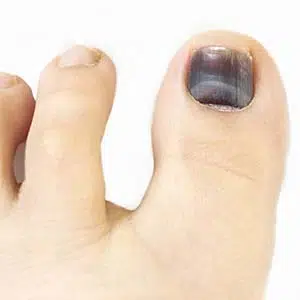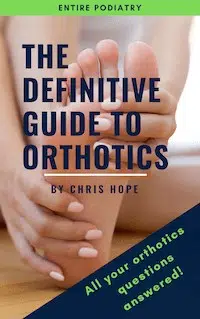 Black toenail, otherwise known as “tennis toe” or “runner’s toe”, is most commonly seen in long-distance runners. The nature of training for long distance running events can cause repetitive trauma to the toes which leads to bleeding beneath the toenails (subungual hematoma). The accumulation of blood causes the discoloration under the toenails.
Black toenail, otherwise known as “tennis toe” or “runner’s toe”, is most commonly seen in long-distance runners. The nature of training for long distance running events can cause repetitive trauma to the toes which leads to bleeding beneath the toenails (subungual hematoma). The accumulation of blood causes the discoloration under the toenails.
How are black toenails treated?
If your black toenails are painful, your Podiatrist can drain the accumulated blood from beneath the affected toenails. This can enable significant symptom relief through reducing pressure beneath the toenail, speeding up the recovery process. If the affected toenails are tender, your Podiatrist can use a local anaesthetic to numb the area prior to drainage. If required, a numbing spray can also be used before the local anaesthetic injection.
For specific footwear advice, bring your running shoes along to your podiatry appointment so we can assess your footwear fit, and provide further advice so that black toenails don’t stop you in your running tracks.
How can I avoid black toenails?
Avoiding black toenails doesn’t mean you have to hang up your running shoes. If it is not painful, keep on running, but check out whether any of these factors may be contributing to your black toenails:
- Running shoes too small?
Although our feet generally stop growing after adolescence, other factors can cause your feet to change in shoe size for many years into adulthood. For example, during pregnancy and with changes in your weight, ligaments in the foot can elongate causing the foot to lengthen. So even if your teenage years are far behind you, don’t neglect the need to still have your feet properly measured at least every few years to ensure you are purchasing the right sized shoe. You should have a fingers’ breadth of room between your longest toe and the front of your running shoes, to avoid repetitive trauma to your toes.
- Toe box of shoes too small?
So, your running shoes may be the right length, but what about the size of the toe box? Some shoes are manufactured with only a small toe box, causing your toes to be tightly packed, especially if you have a wider foot. This can cause not only black toenails but also ingrown toenails. Make sure you are buying shoes that give your toes a little room to wiggle.
- Are your shoe laces tight enough?
Thinking of giving your toes a bit more room by loosening those laces? Think again. If your laces are too loose then this can create too much room in your shoes, causing your feet to slip forward and hitting your toes against the front of your shoes. Make sure your laces are firm to reduce the chance of your feet slipping, and when lacing your shoes make sure the laces go through all of the eyelets. This helps your feet to be more secure within the shoes and minimises forward slipping.
- Toenails too long?
Black toenails can also be caused by long toenails, increasing the chance of trauma from nails hitting against the front of your shoes. It might sound simple but it’s amazing how easy it can be to neglect this simple task! So save your toes by making sure your toenails aren’t too long.
Are all black toenails due to subungual hematoma?
While subungual hematoma is the most common cause of black discoloration beneath the toenails, there are other potentially serious causes that are important to consider and rule out. If there are concerns about another possible cause for your black toenail, your Podiatrist can refer you to the most appropriate medical specialist for further opinion and management.





